SLLSE89G September 2011 – January 2015 ISO7640FM , ISO7641FM
UNLESS OTHERWISE NOTED, this document contains PRODUCTION DATA.
- 1 Features
- 2 Applications
- 3 Description
- 4 Revision History
- 5 Pin Configuration and Functions
-
6 Specifications
- 6.1 Absolute Maximum Ratings
- 6.2 ESD Ratings
- 6.3 Recommended Operating Conditions
- 6.4 Thermal Information
- 6.5 Electrical Characteristics: VCC1 and VCC2 at 5 V ±10%
- 6.6 Electrical Characteristics: VCC1 at 5 V ±10% and VCC2 at 3.3 V ±10%
- 6.7 Electrical Characteristics: VCC1 at 3.3 V ±10% and VCC2 at 5 V ±10%
- 6.8 Electrical Characteristics: VCC1 and VCC2 at 3.3 V ±10%
- 6.9 Electrical Characteristics: VCC1 and VCC2 at 2.7 V
- 6.10 Supply Current: VCC1 and VCC2 at 5 V ±10%
- 6.11 Supply Current: VCC1 at 5 V ±10% and VCC2 at 3.3 V ±10%
- 6.12 Supply Current: VCC1 at 3.3 V ±10% and VCC2 at 5 V ±10%
- 6.13 Supply Current: VCC1 and VCC2 at 3.3 V ±10%
- 6.14 Supply Current: VCC1 and VCC2 at 2.7 V
- 6.15 Switching Characteristics: VCC1 and VCC2 at 5 V ±10%
- 6.16 Switching Characteristics: VCC1 at 5 V ±10% and VCC2 at 3.3 V ±10%
- 6.17 Switching Characteristics: VCC1 at 3.3 V ±10% and VCC2 at 5 V ±10%
- 6.18 Switching Characteristics: VCC1 and VCC2 at 3.3 V ±10%
- 6.19 Switching Characteristics: VCC1 and VCC2 at 2.7 V
- 6.20 Typical Characteristics
- 7 Parameter Measurement Information
- 8 Detailed Description
- 9 Application and Implementation
- 10Power Supply Recommendations
- 11Layout
- 12Device and Documentation Support
- 13Mechanical, Packaging, and Orderable Information
Package Options
Mechanical Data (Package|Pins)
- DW|16
Thermal pad, mechanical data (Package|Pins)
- DW|16
Orderable Information
6 Specifications
6.1 Absolute Maximum Ratings(1)
| MIN | MAX | UNIT | ||||
|---|---|---|---|---|---|---|
| Supply voltage(2) | VCC1, VCC2 | –0.5 | 6 | V | ||
| Voltage | INx, OUTx, ENx | –0.5 | VCC + 0.5(3) | V | ||
| Output Current, IO | –15 | 15 | mA | |||
| Maximum junction temperature, TJ | 150 | °C | ||||
| Storage temperature, Tstg | –65 | 150 | °C | |||
(1) Stresses beyond those listed under Absolute Maximum Ratings may cause permanent damage to the device. These are stress ratings only and functional operation of the device at these or any other conditions beyond those indicated under Recommended Operating Conditions is not implied. Exposure to absolute-maximum-rated conditions for extended periods may affect device reliability.
(2) All voltage values except differential I/O bus voltages are with respect to the local ground terminal (GND1 or GND2) and are peak voltage values.
(3) Maximum voltage must not exceed 6 V.
6.2 ESD Ratings
| VALUE | UNIT | |||
|---|---|---|---|---|
| V(ESD) | Electrostatic discharge | Human body model (HBM), per ANSI/ESDA/JEDEC JS-001, all pins(1) | ±4000 | V |
| Charged device model (CDM), per JEDEC specification JESD22-C101, all pins(2) | ±1500 | |||
| Machine model, per JEDEC JESD22-A115-A | ±200 | |||
(1) JEDEC document JEP155 states that 500-V HBM allows safe manufacturing with a standard ESD control process.
(2) JEDEC document JEP157 states that 250-V CDM allows safe manufacturing with a standard ESD control process.
6.3 Recommended Operating Conditions
| MIN | NOM | MAX | UNIT | ||||
|---|---|---|---|---|---|---|---|
| VCC1, VCC2 | Supply voltage | 2.7 | 5.5 | V | |||
| IOH | High-level output current | –4 | mA | ||||
| IOL | Low-level output current | 4 | mA | ||||
| VIH | High-level input voltage | 2 | 5.5 | V | |||
| VIL | Low-level input voltage | 0 | 0.8 | V | |||
| tui | Input pulse duration | ≥3-V Operation | 6.67 | ns | |||
| <3-V Operation | 10 | ||||||
| 1 / tui | Signaling rate | ≥3-V Operation | 0 | 150 | Mbps | ||
| <3-V Operation | 0 | 100 | |||||
| TJ | Junction temperature | –40 | 136 | °C | |||
| TA | Ambient temperature | –40 | 25 | 125 | °C | ||
6.4 Thermal Information
| THERMAL METRIC(1) | ISO76xx | UNIT | ||
|---|---|---|---|---|
| DW (SOIC) | ||||
| 16 PINS | ||||
| RθJA | Junction-to-ambient thermal resistance | 72 | °C/W | |
| RθJC(top) | Junction-to-case(top) thermal resistance | 38 | ||
| RθJB | Junction-to-board thermal resistance | 39 | ||
| ψJT | Junction-to-top characterization parameter | 9.4 | ||
| PD | Maximum Device Power Dissipation | VCC1 = VCC2 = 5.5V, TJ = 150°C, CL = 15 pF Input a 75-MHz 50% duty cycle square wave |
399 | mW |
(1) For more information about traditional and new thermal metrics, see the IC Package Thermal Metrics application report, SPRA953.
6.5 Electrical Characteristics: VCC1 and VCC2 at 5 V ±10%
VCC1 and VCC2 at 5 V ±10% (over recommended operating conditions unless otherwise noted)| PARAMETER | TEST CONDITIONS | MIN | TYP | MAX | UNIT | ||
|---|---|---|---|---|---|---|---|
| VOH | High-level output voltage | IOH = –4 mA; see Figure 9 | VCCO(1) –0.8 | 4.8 | V | ||
| IOH = –20 μA; see Figure 9 | VCCO(1) –0.1 | 5 | |||||
| VOL | Low-level output voltage | IOL = 4 mA; see Figure 9 | 0.2 | 0.4 | V | ||
| IOL = 20 μA; see Figure 9 | 0 | 0.1 | |||||
| VI(HYS) | Input threshold voltage hysteresis | 450 | mV | ||||
| IIH | High-level input current | VIH = VCC at INx or ENx | 10 | μA | |||
| IIL | Low-level input current | VIL = 0 V at INx or ENx | –10 | ||||
| CMTI | Common-mode transient immunity | VI = VCC or 0 V; see Figure 12 | 25 | 75 | kV/μs | ||
(1) VCCO is the supply voltage, VCC1 or VCC2, for the output channel that is being measured.
6.6 Electrical Characteristics: VCC1 at 5 V ±10% and VCC2 at 3.3 V ±10%
VCC1 at 5 V ±10% and VCC2 at 3.3 V ±10% (over recommended operating conditions unless otherwise noted)| PARAMETER | TEST CONDITIONS | MIN | TYP | MAX | UNIT | ||
|---|---|---|---|---|---|---|---|
| VOH | High-level output voltage | IOH = –4 mA; see Figure 9 | OUTx on VCC1 (5V) side | VCC1 – 0.8 | 4.8 | V | |
| OUTx on VCC2 (3.3V) side | VCC2 – 0.4 | 3 | |||||
| IOH = –20 μA; see Figure 9 | OUTx on VCC1 (5V) side | VCC1 – 0.1 | 5 | ||||
| OUTx on VCC2 (3.3V) side | VCC2 – 0.1 | 3.3 | |||||
| VOL | Low-level output voltage | IOL = 4 mA; see Figure 9 | 0.2 | 0.4 | V | ||
| IOL = 20 μA; see Figure 9 | 0 | 0.1 | |||||
| VI(HYS) | Input threshold voltage hysteresis | 430 | mV | ||||
| IIH | High-level input current | VIH = VCC at INx or ENx | 10 | μA | |||
| IIL | Low-level input current | VIL = 0 V at INx or ENx | –10 | ||||
| CMTI | Common-mode transient immunity | VI = VCC or 0 V; see Figure 12 | 25 | 50 | kV/μs | ||
6.7 Electrical Characteristics: VCC1 at 3.3 V ±10% and VCC2 at 5 V ±10%
VCC1 at 3.3 V ±10% and VCC2 at 5 V ±10% (over recommended operating conditions unless otherwise noted)| PARAMETER | TEST CONDITIONS | MIN | TYP | MAX | UNIT | ||
|---|---|---|---|---|---|---|---|
| VOH | High-level output voltage | IOH = –4 mA; see Figure 9 | OUTx on VCC1 (3.3 V) side | VCC1–0.4 | 3 | V | |
| OUTx on VCC2 (5 V) side | VCC2–0.8 | 4.8 | |||||
| IOH = –20 μA; see Figure 9 | OUTx on VCC1 (3.3 V) side | VCC1–0.1 | 3.3 | ||||
| OUTx on VCC2 (5 V) side | VCC2–0.1 | 5 | |||||
| VOL | Low-level output voltage | IOL = 4 mA; see Figure 9 | 0.2 | 0.4 | V | ||
| IOL = 20 μA; see Figure 9 | 0 | 0.1 | |||||
| VI(HYS) | Input threshold voltage hysteresis | 430 | mV | ||||
| IIH | High-level input current | VIH = VCC at INx or ENx | 10 | μA | |||
| IIL | Low-level input current | VIL = 0 V at INx or ENx | –10 | ||||
| CMTI | Common-mode transient immunity | VI = VCC or 0 V; see Figure 12 | 25 | 50 | kV/μs | ||
6.8 Electrical Characteristics: VCC1 and VCC2 at 3.3 V ±10%
VCC1 and VCC2 at 3.3 V ± 10% (over recommended operating conditions unless otherwise noted)| PARAMETER | TEST CONDITIONS | MIN | TYP | MAX | UNIT | ||
|---|---|---|---|---|---|---|---|
| VOH | High-level output voltage | IOH = –4 mA; see Figure 9 | VCCO(1) – 0.4 | 3 | V | ||
| IOH = –20 μA; see Figure 9 | VCCO(1) – 0.1 | 3.3 | |||||
| VOL | Low-level output voltage | IOL = 4 mA; see Figure 9 | 0.2 | 0.4 | V | ||
| IOL = 20 μA; see Figure 9 | 0 | 0.1 | |||||
| VI(HYS) | Input threshold voltage hysteresis | 425 | mV | ||||
| IIH | High-level input current | VIH = VCC at INx or ENx | 10 | μA | |||
| IIL | Low-level input current | VIL = 0 V at INx or ENx | –10 | ||||
| CMTI | Common-mode transient immunity | VI = VCC or 0 V; see Figure 12 | 25 | 50 | kV/μs | ||
(1) VCCO is the supply voltage, VCC1 or VCC2, for the output channel that is being measured.
6.9 Electrical Characteristics: VCC1 and VCC2 at 2.7 V
VCC1 and VCC2 at 2.7 V(1) (over recommended operating conditions unless otherwise noted)| PARAMETER | TEST CONDITIONS | MIN | TYP | MAX | UNIT | ||
|---|---|---|---|---|---|---|---|
| VOH | High-level output voltage | IOH = –4 mA; see Figure 9 | VCCO(2) – 0.5 | 2.4 | V | ||
| IOH = –20 μA; see Figure 9 | VCCO(2) – 0.1 | 2.7 | |||||
| VOL | Low-level output voltage | IOL = 4 mA; see Figure 9 | 0.2 | 0.4 | V | ||
| IOL = 20 μA; see Figure 9 | 0 | 0.1 | |||||
| VI(HYS) | Input threshold voltage hysteresis | 350 | mV | ||||
| IIH | High-level input current | VIH = VCC at INx or ENx | 10 | μA | |||
| IIL | Low-level input current | VIL = 0 V at INx or ENx | –10 | ||||
| CMTI | Common-mode transient immunity | VI = VCC or 0 V; see Figure 12 | 25 | 50 | kV/μs | ||
(1) For 2.7-V operation, max data rate is 100 Mbps.
(2) VCCO is the supply voltage, VCC1 or VCC2, for the output channel that is being measured.
6.10 Supply Current: VCC1 and VCC2 at 5 V ±10%
VCC1 and VCC2 at 5 V ±10% (over recommended operating conditions unless otherwise noted)| PARAMETER | TEST CONDITIONS | MIN | TYP | MAX | UNIT | ||
|---|---|---|---|---|---|---|---|
| ISO7640FM | |||||||
| ICC1 | Disable | EN = 0 V | 0.6 | 1.2 | mA | ||
| ICC2 | 4.5 | 6.6 | |||||
| ICC1 | DC to 1 Mbps | DC Signal: VI = VCC or 0 V, AC Signal: All channels switching with square wave clock input; CL = 15 pF |
0.7 | 1.3 | |||
| ICC2 | 4.6 | 6.7 | |||||
| ICC1 | 10 Mbps | 1.1 | 2 | ||||
| ICC2 | 6.6 | 10.5 | |||||
| ICC1 | 25 Mbps | 1.9 | 3 | ||||
| ICC2 | 9.7 | 14.7 | |||||
| ICC1 | 150 Mbps | 8.2 | 14.5 | ||||
| ICC2 | 35 | 58 | |||||
| ISO7641FM | |||||||
| ICC1 | Disable | EN1 = EN2 = 0 V | 2.6 | 4.2 | mA | ||
| ICC2 | 4.2 | 6.8 | |||||
| ICC1 | DC to 1 Mbps | DC Signal: VI = VCC or 0 V, AC Signal: All channels switching with square wave clock input; CL = 15 pF |
2.7 | 4.3 | |||
| ICC2 | 4.3 | 6.9 | |||||
| ICC1 | 10 Mbps | 3.6 | 4.9 | ||||
| ICC2 | 6 | 8.2 | |||||
| ICC1 | 25 Mbps | 5.1 | 6.6 | ||||
| ICC2 | 8.8 | 11.4 | |||||
| ICC1 | 150 Mbps | 17 | 22 | ||||
| ICC2 | 31 | 42 | |||||
6.11 Supply Current: VCC1 at 5 V ±10% and VCC2 at 3.3 V ±10%
VCC1 at 5 V ±10% and VCC2 at 3.3 V ±10% (over recommended operating conditions unless otherwise noted)| PARAMETER | TEST CONDITIONS | MIN | TYP | MAX | UNIT | ||
|---|---|---|---|---|---|---|---|
| ISO7640FM | |||||||
| ICC1 | Disable | EN = 0 V | 0.6 | 1.2 | mA | ||
| ICC2 | 3.6 | 5.1 | |||||
| ICC1 | DC to 1 Mbps | DC Signal: VI = VCC or 0 V, AC Signal: All channels switching with square wave clock input; CL = 15 pF |
0.7 | 1.3 | |||
| ICC2 | 3.7 | 5.2 | |||||
| ICC1 | 10 Mbps | 1.1 | 2 | ||||
| ICC2 | 5 | 7.1 | |||||
| ICC1 | 25 Mbps | 1.9 | 3 | ||||
| ICC2 | 6.9 | 11 | |||||
| ICC1 | 150 Mbps | 8.2 | 14.5 | ||||
| ICC2 | 24 | 40 | |||||
| ISO7641FM | |||||||
| ICC1 | Disable | EN1 = EN2 = 0 V | 2.6 | 4.2 | mA | ||
| ICC2 | 3.2 | 4.9 | |||||
| ICC1 | DC to 1 Mbps | DC Signal: VI = VCC or 0 V, AC Signal: All channels switching with square wave clock input; CL = 15 pF |
2.7 | 4.3 | |||
| ICC2 | 3.3 | 5 | |||||
| ICC1 | 10 Mbps | 3.6 | 4.9 | ||||
| ICC2 | 4.4 | 5.8 | |||||
| ICC1 | 25 Mbps | 5.1 | 6.6 | ||||
| ICC2 | 6.1 | 7.6 | |||||
| ICC1 | 150 Mbps | 17 | 22 | ||||
| ICC2 | 20.6 | 26.5 | |||||
6.12 Supply Current: VCC1 at 3.3 V ±10% and VCC2 at 5 V ±10%
VCC1 at 3.3 V ±10% and VCC2 at 5 V ±10% (over recommended operating conditions unless otherwise noted)| PARAMETER | TEST CONDITIONS | MIN | TYP | MAX | UNIT | ||
|---|---|---|---|---|---|---|---|
| ISO7640FM | |||||||
| ICC1 | Disable | EN = 0 V | 0.35 | 0.7 | mA | ||
| ICC2 | 4.5 | 6.6 | |||||
| ICC1 | DC to 1 Mbps | DC Signal: VI = VCC or 0 V, AC Signal: All channels switching with square wave clock input; CL = 15 pF |
0.4 | 0.8 | |||
| ICC2 | 4.6 | 6.7 | |||||
| ICC1 | 10 Mbps | 0.7 | 1.2 | ||||
| ICC2 | 6.6 | 10.5 | |||||
| ICC1 | 25 Mbps | 1.1 | 2 | ||||
| ICC2 | 9.7 | 14.7 | |||||
| ICC1 | 150 Mbps | 5 | 8.5 | ||||
| ICC2 | 35 | 58 | |||||
| ISO7641FM | |||||||
| ICC1 | Disable | EN1 = EN2 = 0 V | 1.9 | 2.9 | mA | ||
| ICC2 | 4.2 | 6.8 | |||||
| ICC1 | DC to 1 Mbps | DC Signal: VI = VCC or 0 V, AC Signal: All channels switching with square wave clock input; CL = 15 pF |
2 | 3 | |||
| ICC2 | 4.3 | 6.9 | |||||
| ICC1 | 10 Mbps | 2.5 | 3.5 | ||||
| ICC2 | 6 | 8.2 | |||||
| ICC1 | 25 Mbps | 3.4 | 4.5 | ||||
| ICC2 | 8.8 | 11.4 | |||||
| ICC1 | 150 Mbps | 10.5 | 14.5 | ||||
| ICC2 | 31 | 42 | |||||
6.13 Supply Current: VCC1 and VCC2 at 3.3 V ±10%
VCC1 and VCC2 at 3.3 V ±10% (over recommended operating conditions unless otherwise noted)| PARAMETER | TEST CONDITIONS | MIN | TYP | MAX | UNIT | ||
|---|---|---|---|---|---|---|---|
| ISO7640FM | |||||||
| ICC1 | Disable | EN = 0 V | 0.35 | 0.7 | mA | ||
| ICC2 | 3.6 | 5.1 | |||||
| ICC1 | DC to 1 Mbps | DC Signal: VI = VCC or 0 V, AC Signal: All channels switching with square wave clock input; CL = 15 pF |
0.4 | 0.8 | |||
| ICC2 | 3.7 | 5.2 | |||||
| ICC1 | 10 Mbps | 0.7 | 1.2 | ||||
| ICC2 | 5 | 7.1 | |||||
| ICC1 | 25 Mbps | 1.1 | 2 | ||||
| ICC2 | 6.9 | 11 | |||||
| ICC1 | 150 Mbps | 5 | 8.5 | ||||
| ICC2 | 24 | 40 | |||||
| ISO7641FM | |||||||
| ICC1 | Disable | EN1 = EN2 = 0 V | 1.9 | 2.9 | mA | ||
| ICC2 | 3.2 | 4.9 | |||||
| ICC1 | DC to 1 Mbps | DC Signal: VI = VCC or 0 V, AC Signal: All channels switching with square wave clock input; CL = 15 pF |
2 | 3 | |||
| ICC2 | 3.3 | 5 | |||||
| ICC1 | 10 Mbps | 2.5 | 3.5 | ||||
| ICC2 | 4.4 | 5.8 | |||||
| ICC1 | 25 Mbps | 3.4 | 4.5 | ||||
| ICC2 | 6.1 | 7.6 | |||||
| ICC1 | 150 Mbps | 10.5 | 14.5 | ||||
| ICC2 | 20.6 | 26.5 | |||||
6.14 Supply Current: VCC1 and VCC2 at 2.7 V
VCC1 and VCC2 at 2.7 V (over recommended operating conditions unless otherwise noted)| PARAMETER | TEST CONDITIONS | MIN | TYP | MAX | UNIT | ||
|---|---|---|---|---|---|---|---|
| ISO7640FM | |||||||
| ICC1 | Disable | EN = 0 V | 0.2 | 0.6 | mA | ||
| ICC2 | 3.3 | 5 | |||||
| ICC1 | DC to 1 Mbps | DC Signal: VI = VCC or 0 V, AC Signal: All channels switching with square wave clock input; CL = 15 pF |
0.2 | 0.7 | |||
| ICC2 | 3.4 | 5.1 | |||||
| ICC1 | 10 Mbps | 0.4 | 1.1 | ||||
| ICC2 | 4.4 | 6.8 | |||||
| ICC1 | 25 Mbps | 0.8 | 1.8 | ||||
| ICC2 | 6 | 9.5 | |||||
| ICC1 | 100 Mbps | 2.7 | 5 | ||||
| ICC2 | 14.2 | 21 | |||||
| ISO7641FM | |||||||
| ICC1 | Disable | EN1 = EN2 = 0 V | 1.6 | 2.4 | mA | ||
| ICC2 | 2.8 | 4.1 | |||||
| ICC1 | DC to 1 Mbps | DC Signal: VI = VCC or 0 V, AC Signal: All channels switching with square wave clock input; CL = 15 pF |
1.7 | 2.5 | |||
| ICC2 | 2.9 | 4.2 | |||||
| ICC1 | 10 Mbps | 2.1 | 3 | ||||
| ICC2 | 3.8 | 5 | |||||
| ICC1 | 25 Mbps | 2.8 | 3.8 | ||||
| ICC2 | 5.2 | 6.7 | |||||
| ICC1 | 100 Mbps | 6.4 | 7.5 | ||||
| ICC2 | 11.8 | 15.5 | |||||
6.15 Switching Characteristics: VCC1 and VCC2 at 5 V ±10%
VCC1 and VCC2 at 5 V ±10% (over recommended operating conditions unless otherwise noted)| PARAMETER | TEST CONDITIONS | MIN | TYP | MAX | UNIT | ||
|---|---|---|---|---|---|---|---|
| tPLH, tPHL | Propagation delay time | See Figure 9 | 3.5 | 7 | 10.5 | ns | |
| PWD(1) | Pulse width distortion |tPHL – tPLH| | 2 | |||||
| tsk(o)(2) | Channel-to-channel output skew time | Same-direction Channels | 2 | ||||
| Opposite-direction Channels | 3 | ||||||
| tsk(pp)(3) | Part-to-part skew time | 4.5 | |||||
| tr | Output signal rise time | See Figure 9 | 1.6 | ns | |||
| tf | Output signal fall time | 1 | |||||
| tPHZ | Disable Propagation Delay, high-to-high impedance output | See Figure 10 | 5 | 16 | ns | ||
| tPLZ | Disable Propagation Delay, low-to-high impedance output | 5 | 16 | ||||
| tPZH | Enable Propagation Delay, high impedance-to-high output | 4 | 16 | ||||
| tPZL | Enable Propagation Delay, high impedance-to-low output | 4 | 16 | ||||
| tfs | Fail-safe output delay time from input data or power loss | See Figure 11 | 9.5 | μs | |||
(1) Also known as Pulse Skew.
(2) tsk(o) is the skew between outputs of a single device with all driving inputs connected together and the outputs switching in the same direction while driving identical loads.
(3) tsk(pp) is the magnitude of the difference in propagation delay times between any terminals of different devices switching in the same direction while operating at identical supply voltages, temperature, input signals and loads.
6.16 Switching Characteristics: VCC1 at 5 V ±10% and VCC2 at 3.3 V ±10%
VCC1 at 5 V ±10% and VCC2 at 3.3 V ±10% (over recommended operating conditions unless otherwise noted)| PARAMETER | TEST CONDITIONS | MIN | TYP | MAX | UNIT | ||
|---|---|---|---|---|---|---|---|
| tPLH, tPHL | Propagation delay time | See Figure 9 | 4 | 8 | 13 | ns | |
| PWD(1) | Pulse width distortion |tPHL – tPLH| | 2 | |||||
| tsk(o)(2) | Channel-to-channel output skew time | Same-direction Channels | 2.5 | ||||
| Opposite-direction Channels | 3.5 | ||||||
| tsk(pp)(3) | Part-to-part skew time | 6 | |||||
| tr | Output signal rise time | See Figure 9 | 2 | ns | |||
| tf | Output signal fall time | 1.2 | |||||
| tPHZ | Disable Propagation Delay, high-to-high impedance output | See Figure 10 | 6.5 | 17 | ns | ||
| tPLZ | Disable Propagation Delay, low-to-high impedance output | 6.5 | 17 | ||||
| tPZH | Enable Propagation Delay, high impedance-to-high output | 5.5 | 17 | ||||
| tPZL | Enable Propagation Delay, high impedance-to-low output | 5.5 | 17 | ||||
| tfs | Fail-safe output delay time from input data or power loss | See Figure 11 | 9.5 | μs | |||
(1) Also known as Pulse Skew.
(2) tsk(o) is the skew between outputs of a single device with all driving inputs connected together and the outputs switching in the same direction while driving identical loads.
(3) tsk(pp) is the magnitude of the difference in propagation delay times between any terminals of different devices switching in the same direction while operating at identical supply voltages, temperature, input signals and loads.
6.17 Switching Characteristics: VCC1 at 3.3 V ±10% and VCC2 at 5 V ±10%
VCC1 at 3.3 V ±10% and VCC2 at 5 V ±10% (over recommended operating conditions unless otherwise noted)| PARAMETER | TEST CONDITIONS | MIN | TYP | MAX | UNIT | ||
|---|---|---|---|---|---|---|---|
| tPLH, tPHL | Propagation delay time | See Figure 9 | 4 | 7.5 | 12.5 | ns | |
| PWD(1) | Pulse width distortion |tPHL – tPLH| | 2 | |||||
| tsk(o)(2) | Channel-to-channel output skew time | Same-direction Channels | 2.5 | ||||
| Opposite-direction Channels | 3.5 | ||||||
| tsk(pp)(3) | Part-to-part skew time | 6 | |||||
| tr | Output signal rise time | See Figure 9 | 1.7 | ns | |||
| tf | Output signal fall time | 1.1 | |||||
| tPHZ | Disable Propagation Delay, high-to-high impedance output | See Figure 10 | 5.5 | 17 | ns | ||
| tPLZ | Disable Propagation Delay, low-to-high impedance output | 5.5 | 17 | ||||
| tPZH | Enable Propagation Delay, high impedance-to-high output | 4.5 | 17 | ||||
| tPZL | Enable Propagation Delay, high impedance-to-low output | 4.5 | 17 | ||||
| tfs | Fail-safe output delay time from input data or power loss | See Figure 11 | 9.5 | μs | |||
(1) Also known as Pulse Skew.
(2) tsk(o) is the skew between outputs of a single device with all driving inputs connected together and the outputs switching in the same direction while driving identical loads.
(3) tsk(pp) is the magnitude of the difference in propagation delay times between any terminals of different devices switching in the same direction while operating at identical supply voltages, temperature, input signals and loads.
6.18 Switching Characteristics: VCC1 and VCC2 at 3.3 V ±10%
VCC1 and VCC2 at 3.3 V ±10% (over recommended operating conditions unless otherwise noted)| PARAMETER | TEST CONDITIONS | MIN | TYP | MAX | UNIT | ||
|---|---|---|---|---|---|---|---|
| tPLH, tPHL | Propagation delay time | See Figure 9 | 4 | 8.5 | 14 | ns | |
| PWD(1) | Pulse width distortion |tPHL – tPLH| | 2 | |||||
| tsk(o)(2) | Channel-to-channel output skew time | Same-direction Channels | 3 | ||||
| Opposite-direction Channels | 4 | ||||||
| tsk(pp)(3) | Part-to-part skew time | 6.5 | |||||
| tr | Output signal rise time | See Figure 9 | 2 | ns | |||
| tf | Output signal fall time | 1.3 | |||||
| tPHZ | Disable Propagation Delay, high-to-high impedance output | See Figure 10 | 6.5 | 17 | ns | ||
| tPLZ | Disable Propagation Delay, low-to-high impedance output | 6.5 | 17 | ||||
| tPZH | Enable Propagation Delay, high impedance-to-high output | 5.5 | 17 | ||||
| tPZL | Enable Propagation Delay, high impedance-to-low output | 5.5 | 17 | ||||
| tfs | Fail-safe output delay time from input data or power loss | See Figure 11 | 9.2 | μs | |||
(1) Also known as Pulse Skew.
(2) tsk(o) is the skew between outputs of a single device with all driving inputs connected together and the outputs switching in the same direction while driving identical loads.
(3) tsk(pp) is the magnitude of the difference in propagation delay times between any terminals of different devices switching in the same direction while operating at identical supply voltages, temperature, input signals and loads.
6.19 Switching Characteristics: VCC1 and VCC2 at 2.7 V
VCC1 and VCC2 at 2.7 V (over recommended operating conditions unless otherwise noted)| PARAMETER | TEST CONDITIONS | MIN | TYP | MAX | UNIT | ||
|---|---|---|---|---|---|---|---|
| tPLH, tPHL | Propagation delay time | See Figure 9 | 5 | 8 | 16 | ns | |
| PWD(1) | Pulse width distortion |tPHL – tPLH| | 2.5 | |||||
| tsk(o)(2) | Channel-to-channel output skew time | Same-direction Channels | 4 | ||||
| Opposite-direction Channels | 5 | ||||||
| tsk(pp)(3) | Part-to-part skew time | 8 | |||||
| tr | Output signal rise time | See Figure 9 | 2.3 | ns | |||
| tf | Output signal fall time | 1.8 | |||||
| tPHZ | Disable Propagation Delay, high-to-high impedance output | See Figure 10 | 8 | 18 | ns | ||
| tPLZ | Disable Propagation Delay, low-to-high impedance output | 8 | 18 | ||||
| tPZH | Enable Propagation Delay, high impedance-to-high output | 7 | 18 | ||||
| tPZL | Enable Propagation Delay, high impedance-to-low output | 7 | 18 | ||||
| tfs | Fail-safe output delay time from input data or power loss | See Figure 11 | 8.5 | μs | |||
(1) Also known as Pulse Skew.
(2) tsk(o) is the skew between outputs of a single device with all driving inputs connected together and the outputs switching in the same direction while driving identical loads.
(3) tsk(pp) is the magnitude of the difference in propagation delay times between any terminals of different devices switching in the same direction while operating at identical supply voltages, temperature, input signals and loads.
6.20 Typical Characteristics
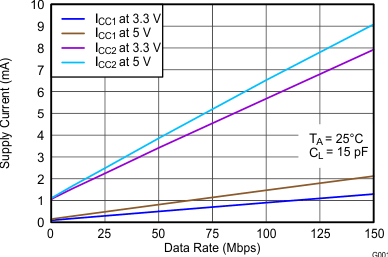 Figure 1. ISO7640FM Supply Current per Channel
Figure 1. ISO7640FM Supply Current per Channel vs Data Rate
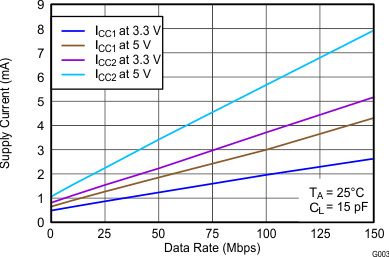 Figure 3. ISO7641FM Supply Current per Channel
Figure 3. ISO7641FM Supply Current per Channelvs Data Rate
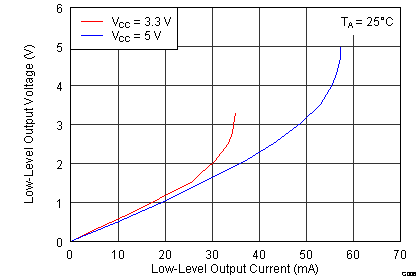 Figure 5. Low-Level Output Voltage
Figure 5. Low-Level Output Voltagevs Low-Level Output Current
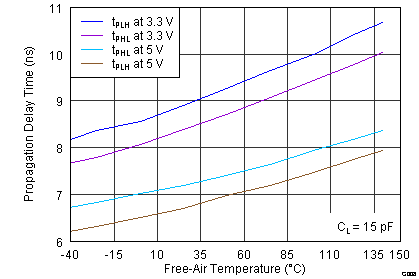 Figure 7. Propagation Delay Time
Figure 7. Propagation Delay Timevs Free Air Temperature
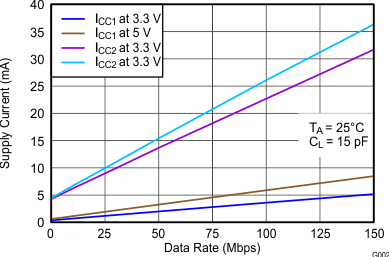 Figure 2. ISO7640FM Supply Current for All Channels
Figure 2. ISO7640FM Supply Current for All Channelsvs Data Rate
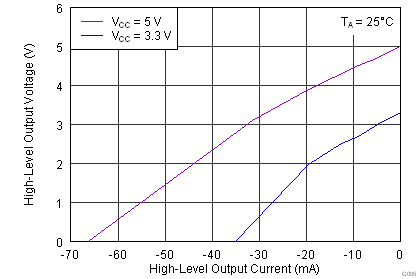 Figure 4. High-Level Output Voltage
Figure 4. High-Level Output Voltagevs High-Level Output Current
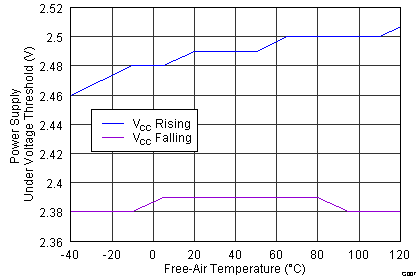 Figure 6. VCC Undervoltage Threshold
Figure 6. VCC Undervoltage Thresholdvs Free Air Temperature
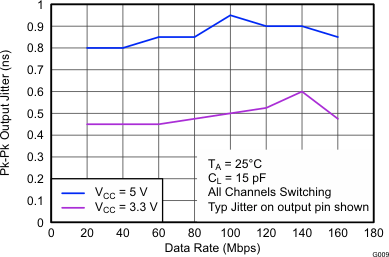 Figure 8. Output Jitter vs Data Rate
Figure 8. Output Jitter vs Data Rate